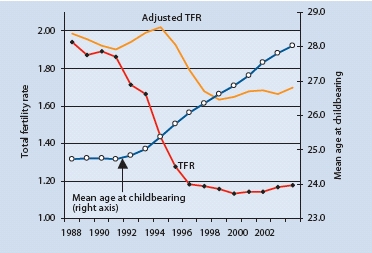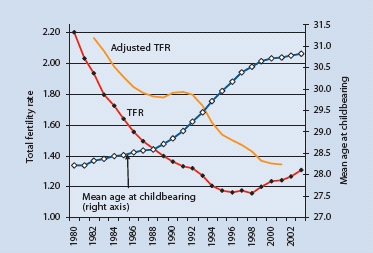Tempo Effect and Adjusted TFR
The conventionally reported indicator of the level of fertility in a given calendar year (the period Total Fertility Rate or TFR) reflects the interplay of two components: tempo (timing) and quantum (level) of fertility. The tempo component affects the TFR when the timing of childbearing over the life cycle changes. In Europe many countries are currently experiencing a postponement of births, which is also reflected in an increasing mean age of childbearing. This results in a decline in the number of births in the current year and therefore depresses the period TFR, even if the number of children that women have over their life course does not change. One can also think of this tempo effect in terms of an expansion of the interval between generations during which fewer births fall into each calendar year.
In order to come up with a measure of the level (quantum) of fertility in a given calendar year that is free from the tempo effect and therefore a better indicator for the average number of children per woman than the observed period TFR, the “tempo-adjusted TFR” has recently been developed. The adjusted TFR as listed in this data sheet is calculated on the basis of the Bongaarts-Feeney (1998) formula which uses fertility data by birth order. The sheet gives the mean of the adjusted TFR for the three-year period 2001–2003. For countries for which no such data is available the adjusted TFR is estimated on the basis of a regression relating the observed change in the mean age of childbearing to the size of the tempo effect.
Figure 1 illustrates the tempo adjustment for the Czech Republic where postponement was particularly pronounced after 1992 and the TFR fell sharply in tandem with an increase in the mean age at childbearing, reaching a low of 1.13 in 1999.

The trend in the adjusted TFR shows that most of this drop was due to tempo effects linked to fertility postponement. In Spain (see Figure 2) the pattern has been quite different, with the adjusted TFR following the decline in the conventional TFR and a divergence only emerging for the early 1990s when significant postponement occurred. In Spain, recently the increase in the mean age of childbearing has levelled off and, as a consequence, the difference between the two fertility measures has almost disappeared, showing a slight increase in TFR combined with a continued decline of fertility quantum represented by the adjusted TFR.
As to the future fertility trends, the Spanish example shows that an end of postponement does not necessarily result in a significant increase in the TFR if the quantum of fertility declines simultaneously, i.e. if some of the postponed births are not recuperated. The future level of the quantum of fertility is an open question and there is no good theory to tell us whether it will be stable, recover or continue to decline. Population projections need to reflect this uncertainty.
